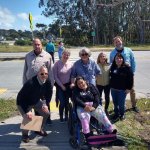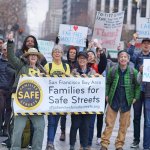There’s now more transparency in the aftermath of a fatal crash
Last year, 20 pedestrians were hit and killed on San Francisco streets, and 37 people in total were killed in all traffic crashes.
The aftermath of a fatal crash leaves many questions, including details on the circumstances of the crash and what type of street design changes could have prevented the crash. But a new initiative provides greater transparency on these questions.
The City’s Vision Zero Traffic Fatality Protocol will now require the City to publicly display, both online and at the fatality site, all known details on what led to the crash, SFMTA notes on actions and observations about the crash site, and an update on SFPD’s investigation. This information will all be publicly accessible through a new traffic fatality tracker within 14 days of a crash, with updates thereafter.
Walk SF believes more transparency can bring greater accountability to the City on Vision Zero, plus help communities understand what’s happening on their streets and mobilize for changes. We’re grateful to Supervisor Dean Preston for his leadership on this, and to SFMTA, SFPD, and DPH for working together on this new initiative.
The Vision Zero Traffic Fatality Protocol already required the SFMTA to convene a Rapid Response call with DPH and SFPD within a week of a traffic fatality. The SFMTA will also continue to send out a “Rapid Response team” within 48 hours of a crash to review the details of the crash and consider immediate street improvements. And each month, the City will continue to release a fatality report with the locations, dates, and causes of each traffic death. You can view these here.
At the heart of the Vision Zero approach is that traffic crashes are not inevitable – they are preventable. We need to be sure that when a horrific tragedy does occur somewhere in our city, everything possible is done to ensure it never happens there again.
Banner image by Nick Giorgio




